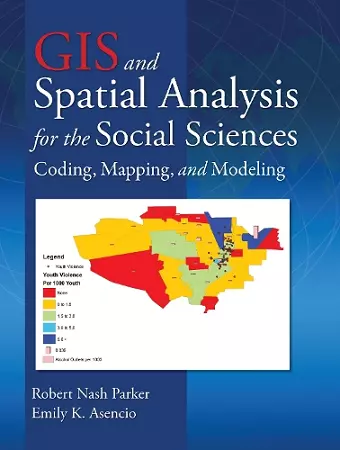GIS and Spatial Analysis for the Social Sciences
Coding, Mapping, and Modeling
Robert Nash Parker author Emily K Asencio author
Format:Hardback
Publisher:Taylor & Francis Ltd
Published:25th Jul '08
Currently unavailable, and unfortunately no date known when it will be back
This hardback is available in another edition too:
- Paperback£89.99(9780415989626)

This is the first book to provide sociologists, criminologists, political scientists, and other social scientists with the methodological logic and techniques for doing spatial analysis in their chosen fields of inquiry.
The book contains a wealth of examples as to why these techniques are worth doing, over and above conventional statistical techniques using SPSS or other statistical packages.
GIS is a methodological and conceptual approach that allows for the linking together of spatial data, or data that is based on a physical space, with non-spatial data, which can be thought of as any data that contains no direct reference to physical locations.
"GIS and spatial analysis have made major inroads into the social sciences, yet it is challenging for researchers to find accessible introductions to these techniques. Parker and Asencio have provided a book that reduces the costs of entry into the field. Their manuscript has well-written and informative chapters on geocoding, mapping for analysis, and geospatial modeling. The book is loaded with screen shots that enable the reader to take a step-by-step approach to using ArcGIS software. I highly recommend this book to researchers who want to use ArcGIS to incorporate geospatial analysis into their projects." – Ken Bollen, Immerwahr Distinguished Professor, University of North Carolina, Chapel Hill
"Through a series of fascinating examples, this book integrates GIS software with spatial modeling and statistical analysis. Students will appreciate its careful hands-on step-by-step approach–and so will their teachers."–David McDowall, School of Criminal Justice, University at Albany
"This is highly accessible, clearly written and ambly illustrated book. It provides both practical and conceptual information for those interested in understanding and applying GIS. It is a great resource to students, instructurs and other analysts whether they are first-time or more seasoned users of GIS as a tool for social research involving a wide range of disciplines and specialities." Norman Giesbrecht, Senior Scientist, Center for Addiction & Mental Health, Toronto
"This is a first-rate book on GIS and spatial analysis. The authors adopt a "learn-by-doing" approach and make it work by combining lucid explanations of concepts and procedures with rich examples. The book will be a valuable resource to students, teachers, and researchers interested in understanding the spatial dimension of social life." –Steven F. Messner, Distinguished Teaching Professor of Sociology, University at Albany, SUNY
"This book is an excellent introduction to the latest tools and techniques for using spatial analyses to study behavior. It is written in a clear and step-by-step fashion with ample illustrations and enables the reader to quickly engage the complex tools of GIS including details concerning appropriate statistical analyses which go well beyond plotting data on maps." –Harold D. Holder, Ph.D., Senior Research Scientist, Prevention Research Center, Pacific Institute for Research and Evaluation, Berkeley, California.
"Many books on GIS are either too general, too specific to software systems, or too technical (e.g., oriented toward geographers / cartographers). So social scientists’ needs are neglected. I strongly recommend that anyone with a serious interest in social ecology get to know GIS intimately. But for the beginner these texts are just too much to wade through. Texts on spatial analysis, without a good background in matrix algebra and calculus, are simply too difficult for many students and put them off the topic. The answer to the core scientific question "Why bother?" is not forthcoming from these texts, at least not in any direct way. The proposed text fills these gaps nicely."
"This book has the potential to become a widely used manual for sociologists and other social analysts interested in learning and using the basic principles of GIS as a method of analysis and presentation. By strategically deploying substantive problems for students to consider, the book provides a path to learn the technicalities and the craft of GIS. The book constitutes a creative and effective approach to what is increasingly a commonly relied upon method of analysis in sociology, economics, geography, political science and other disciplines that take the social organization of space seriously. As such, it is poised to become a valuable resource for undergraduate students, graduate students, and policy analysts in both the public and private sector." - Valerie Jenness, University of California, Irvine and Routledge Series Advisor in Sociology and Co-Editor, Contemporary Sociology.
"This is a first-rate book on GIS and spatial analysis. The authors adopt a "learn-by-doing" approach and make it work by combining lucid explanations of concepts and procedures with rich examples. The book will be a valuable resource to students, teachers, and researchers interested in understanding the spatial dimension of social life." –Steven F. Messner, Distinguished Teaching Professor of Sociology, University at Albany, SUNY
"This book is an excellent introduction to the latest tools and techniques for using spatial analyses to study behavior. It is written in a clear and step-by-step fashion with ample illustrations and enables the reader to quickly engage the complex tools of GIS including details concerning appropriate statistical analyses which go well beyond plotting data on maps." –Harold D. Holder, Ph.D., Senior Research Scientist, Prevention Research
ISBN: 9780415989619
Dimensions: unknown
Weight: 660g
254 pages